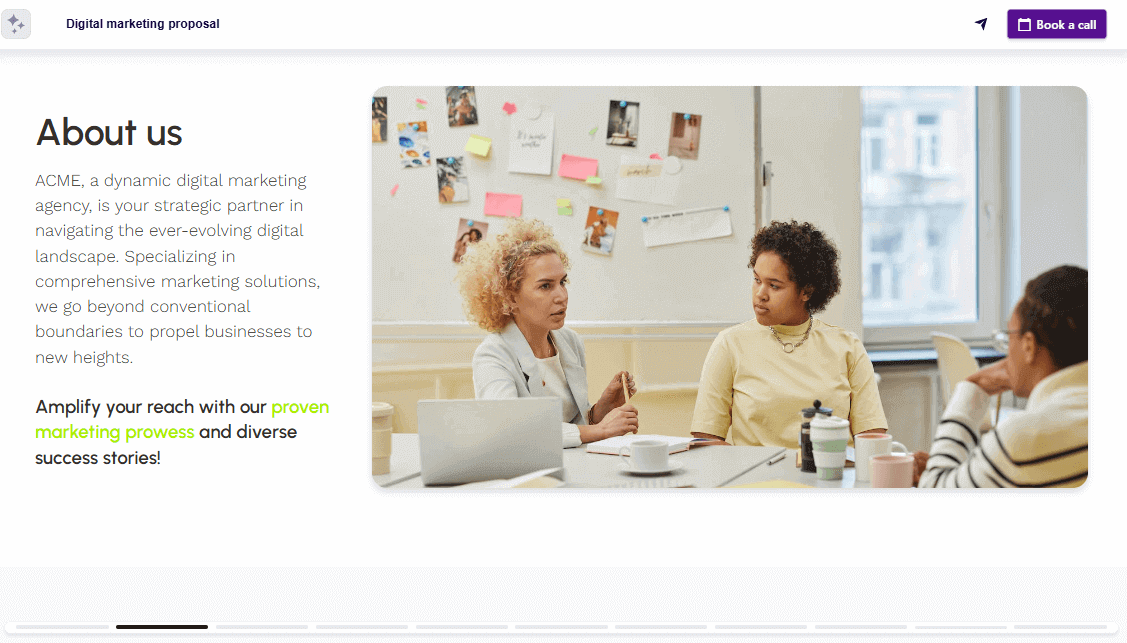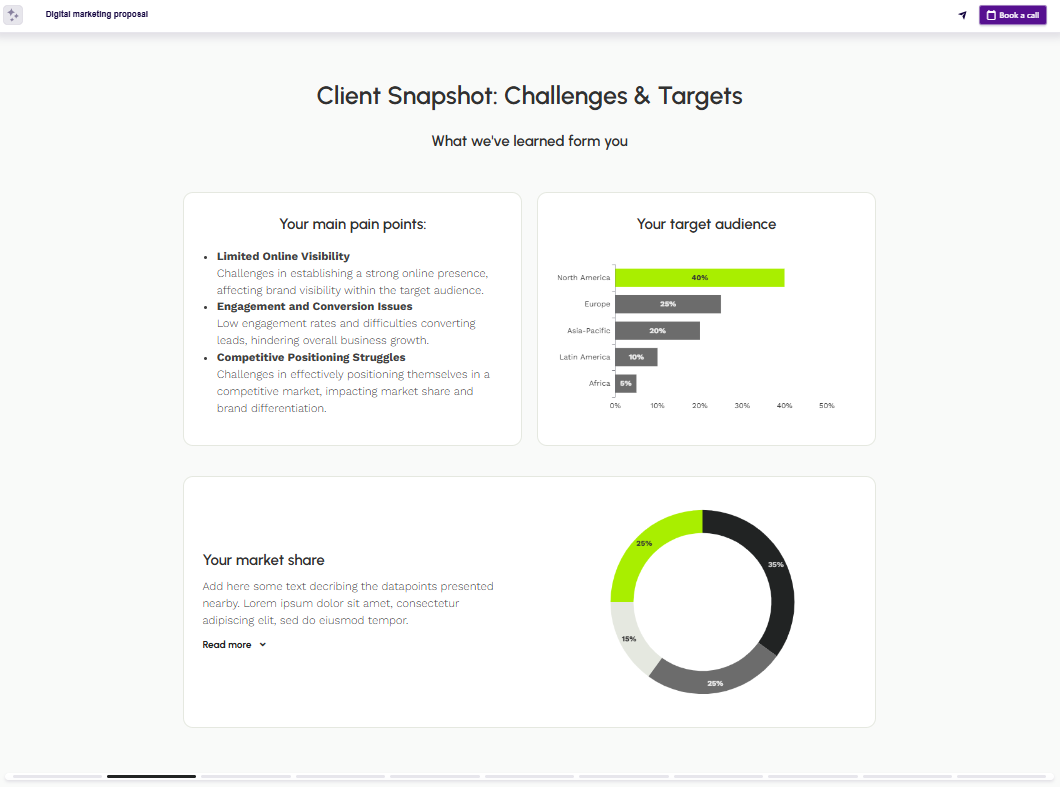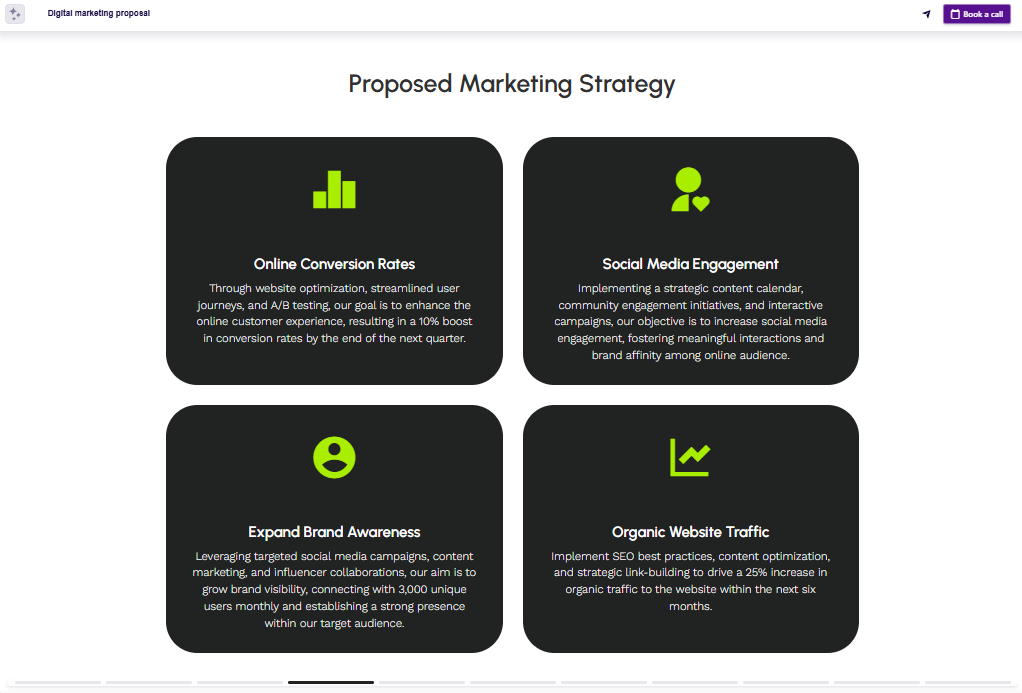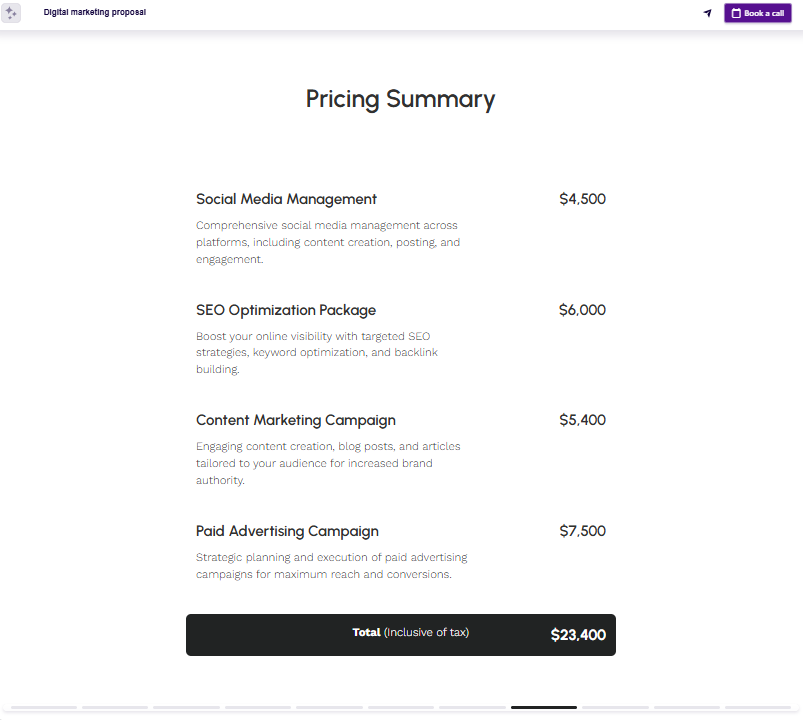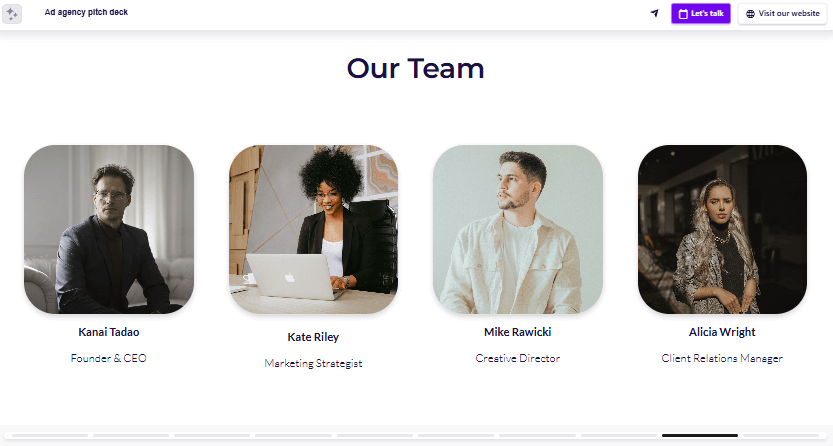How to Create a Marketing Deck (Strategy, Tips & Templates)
Learn how to create a killer marketing deck with our strategy, tips, and templates. Stand out from the crowd and make your pitch irresistible.


Learn how to create a killer marketing deck with our strategy, tips, and templates. Stand out from the crowd and make your pitch irresistible.
Short answer
A marketing deck is a presentation used by businesses or agencies to pitch their marketing strategy, services, or proposals. It helps attract clients, investors, or partners by visually explaining key ideas.
A marketing deck is used for sending cold outreach, shared with inbound leads, or used in response to an RFP.
Who is a marketing deck for?
Marketing decks are used by agencies, startups, and businesses that need to pitch their marketing ideas or services.
Agencies use them to win clients, startups to attract investors, and companies to align teams. Whether for outreach, sales, or funding, a strong deck makes marketing efforts more persuasive.
What are the goals of a marketing deck?
A marketing deck helps businesses and agencies communicate their marketing strategy in a clear, compelling way. Its main goals include:
Winning clients – Show potential customers why your marketing services are the right fit.
Securing investment – Convince investors that your marketing plan is worth funding.
Selling a product or service – Explain how your offering solves a problem and why it stands out.
Aligning teams and partners – Get everyone on the same page about your marketing approach or report on the outcomes of your marketing strategies.
Responding to RFPs – Present your strategy in a structured, professional way to win contracts.
What assets do I need before writing a marketing deck?
Before creating a marketing deck, you’ll need key information and materials to make it persuasive and professional. Here’s what to prepare:
Your marketing strategy – A clear plan outlining your goals, target audience, and approach.
Case studies or portfolio – Examples of past work that prove your success.
Data and research – Market insights, audience analysis, or performance metrics to back up your claims.
Branding assets – Logos, color schemes, and visuals that keep your deck looking polished.
Pricing and service details – A clear breakdown of what you’re offering and at what cost.
Client testimonials – Social proof that builds trust and credibility.
If you’re responding to an RFP, make sure you also have the client’s requirements so your deck speaks directly to their needs.
What to include on your title slide
Your company name and logo – Reinforce your brand identity.
A compelling title – This could be as simple as “[Your Company Name] | Marketing Solutions for [Recipient Name].”
The recipient’s name and logo – Personalizing the deck makes it feel tailor-made.
A background image or subtle animation – Keep it clean but visually appealing.
A short tagline (optional) – If you have a strong value proposition, this is the place for it.
A short welcome video (optional) – A brief, engaging clip introducing your company can create an instant connection.
💡 Pro tip: For client decks, use dynamic tags to pull in their names, industries, or key details from your CRM, so every title slide feels customized without extra manual work.
What to include on your introduction slide
A short, powerful opening statement – Think of this as your elevator pitch in one or two sentences.
Your company name and what you do – Keep it clear and direct.
Key credentials or achievements – Awards, years in business, notable clients, or metrics that prove your success.
A team photo or founder image (optional) – A human touch can make your deck feel more personal.
A quick video introduction (optional) – If relevant, a short clip introducing your company can make an impact.
What to include in your market analysis
Market size and potential – Show the scale of opportunity, backed by reliable data.
Key segments and audience insights – Who are the main customer groups, and what drives their decisions?
Current industry trends – Show key shifts in consumer behavior, technology, or competition that could impact your strategy.
Competitive landscape – Break down where your prospect, company, or product fits in the market and where there’s room to stand out, improve, or gain an edge.
Relevant statistics and visualizations – Use clear, compelling charts, graphs, or interactive data to make key insights instantly understandable and more impactful.
For investors – Investors don’t just want numbers; they want a big-picture opportunity. Focus on how large the market is (TAM), how fast it’s growing, and why your company is positioned to win. Use data to prove demand and scalability.
For internal teams – Share key audience insights and industry trends to help shape your next marketing strategy.
How to structure the problem slide
List the key pain points as short, bold statements – If you’re pitching to a prospect, use their exact language whenever possible.
Reinforce with data – When needed, back up the problem with market trends, audience insights, or competitor analysis so it’s impossible to ignore.
Make it visual – Ditch the long paragraphs. A bold list, a side-by-side comparison, or a striking stat will make the pain points hit harder.
How to structure the solution slide
Mirror their language – Frame your solution in the same terms they use to describe their challenges.
Make it specific – Instead of saying “We offer SEO solutions,” say, “Our backlinks service will help you earn high-authority links to improve your domain ranking and drive more qualified traffic.”
Align each solution with a clear objective – What’s the desired outcome for them?
Use a structured format – A problem-solution grid, before-and-after comparison, or a phased strategy roadmap makes your approach easier to follow.
For investor decks, focus on how your solution scales, its competitive edge, and the potential for growth and profitability.
What to include in your marketing strategy
Marketing channels – Show where and how you’ll connect with your audience, whether through paid ads, SEO, social media, email, or content marketing. Focus on the channels that matter most to them.
Key tactics for each channel – Outline exactly what you'll do to drive results, like retargeting ads to recapture leads, influencer partnerships to boost credibility, or A/B testing to refine messaging.
Campaign timeline or rollout phases – Show when each tactic will be executed to create a clear roadmap.
Expected outcomes – Tie strategies to measurable goals (e.g., “Increase website traffic by 40% in six months”).
Budget allocation (optional) – A high-level breakdown of how resources will be distributed across channels.
How to present your UVP
I) Clearly define what sets you apart from competitors
Maybe it’s your cutting-edge technology, unbeatable pricing, hands-on customer service, or industry expertise—whatever it is, don’t just state it. Show why it matters.
Your USP isn’t just about being different; it’s about solving a problem in a way no one else can.
Once you’ve nailed your USPs down, they should be crystal clear and impossible to miss in your marketing deck.
II) Highlight your company's values and mission
People don’t just buy from businesses—they buy from brands they believe in. If your company has a strong mission, ethical stance, or customer-first philosophy, make sure it’s clear.
Whether it’s sustainability, innovation, or next-level service, your values can be the reason someone chooses you over a competitor.
The right values don’t just make you relatable—they make you the obvious choice for the right audience.
III) Mention any patents, proprietary technology, or unique know-how
If you have patented technology, a unique approach, or deep industry expertise, don’t just mention it—make it a key part of your story.
These are the things that give you an edge and make it tough for anyone else to compete.
When you show what you’ve built, what you know, and what only you can offer, you’re not just proving you’re qualified—you’re making it clear why you’re the best choice.
The more undeniable your expertise, the easier it is to win business.
How to incorporate social proof into your marketing deck
Showcase logos of your most noteworthy clients – This can establish your brand as a trusted partner in your industry and give your audience a sense of confidence in your offering.
Display customer reviews and ratings – Sharing positive experiences from real customers can demonstrate the value and benefits of your product or service.
Showcase any awards your company has received – Whether it’s an industry award, recognition for innovation, or top-rated customer service, these add credibility and reinforce your expertise.
Use influencers or case studies – The right influencers put you in front of new audiences and build trust fast. Case studies let prospects see real customers getting real results, making the value clear.
Show the numbers that matter – Stats tell the real story. Highlight meaningful metrics like “$2.5M revenue last quarter” or “300% organic traffic growth in six months” to prove your impact.
For investor decks – You probably don’t have client success stories yet, so lean on traction and early adopter data. User adoption, revenue trends, and retention show market demand and long-term potential.
How to present your pricing structure
A structured breakdown of pricing – Whether it’s a single set price or a detailed line-item breakdown (e.g., Service A = $X, Service B = $Y), make costs clear and easy to understand.
Different pricing tiers (if applicable) – Offer choices, like “Basic, Pro, and Enterprise,” to cater to different budgets.
Custom or flexible pricing options – If pricing varies, mention that plans can be tailored to fit specific needs.
Any discounts or incentives – Whether it’s bundled pricing, long-term commitment discounts, or free add-ons, make it clear.
For investor decks – Instead of client-facing pricing, focus on your revenue model. Also, outline how much funding you're seeking and how it will be allocated to drive growth—whether for marketing expansion, product development, or scaling operations.
For internal decks – If applicable, you can use this slide to align sales and marketing teams on pricing strategies, discounts, and positioning. If relevant, include cost breakdowns or margin analysis to guide pricing decisions.
How to present the team slide
Key team members – Feature the people directly involved in the client’s success (not the entire company).
Photos + short bios – Keep bios concise, focusing on expertise and relevant experience.
Roles and responsibilities – Clarify who will handle what, so the client knows exactly who they’ll be working with.
Notable achievements – Highlight key successes, like campaigns led, brands worked with, or results achieved.
For investor decks – Investors want to know if your team has the experience and leadership to execute the business vision. Highlight founders, executives, and key hires, along with what makes your team uniquely qualified to scale the company.
For internal decks – Use this slide to clarify team roles and responsibilities, especially for large projects. This helps ensure alignment, accountability, and smooth collaboration.
Examples of effective CTAs
E-signature box – Let them sign the agreement on the spot if they’re ready.
Embedded calendar link – Schedule a follow-up call without back-and-forth emails.
Website or landing page link – Direct them to learn more or explore additional resources.
Interactive contact form – Allow them to express interest, ask questions, or request a custom quote.
Downloadable resources – Offer an extra case study or a detailed service overview.
Next steps checklist – A simple breakdown of what happens next (e.g., "Step 1: Sign agreement, Step 2: Kickoff call").
Stop losing opportunities to ineffective presentations.
Your new amazing deck is one click away!







